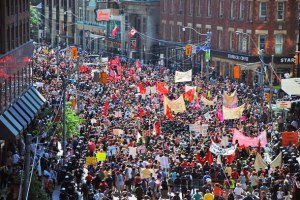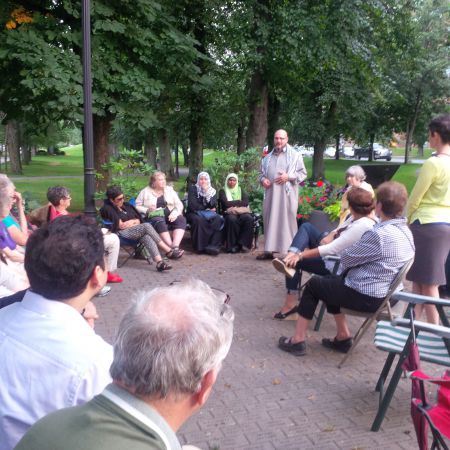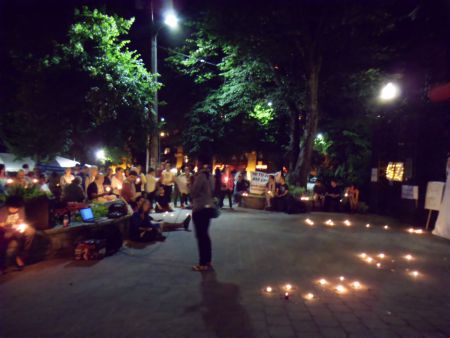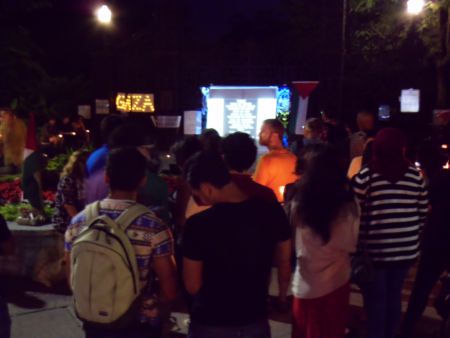Former Solidarity Halifax member David Bush sets some way points for what needs to be done during and after the People’s Social Forum in August. Bush points to Solidarity Halifax as among the few new organizations that have helped set a way forward. Originally published at Hammerhearts.

With the Peoples’ Social Forum approaching in August I thought I would jot down a couple of ideas about where the left is, what challenges it’s facing and what roads it could take.
Before I begin I want to list where I am coming from politically to help frame my analysis. I do this because we can’t divorce the question of how we should organize ourselves from our political objectives. That being said the purpose of this post is to focus on the former not the latter.
- The major problems we face, climate change, growing inequality, democratic dispossession, etc. are the result of our political and economic system – capitalism.
- These problems can’t be solved within the capitalist system thus we need to replace capitalism with some sort of democratic socialist society.
- This can only happen if the working class itself takes charge in creating a more just society.
- The working class should not be reduced to stilted images of factory workers – the working class is multifaceted and complex but shares a common relation to property and labour.
- The working class is strategically located to overthrow capitalism because of its centrality to the capitalist economic system, but workers cannot be reduced to mere class. Nor can class politics exist without anti-oppression politics.
- The self-emancipation of the working class from capitalism can’t happen without recognizing and actively supporting the self-determination of First Nations.
Where is the left?
I am not going to spend much time on the state of the left. So much has been said about this it barely seems worth repeating. Over the past few years there have been some amazing social movements in the country. Occupy, the Quebec student strike, the environmental movement and Idle No More being the most notable. However, the left in Canada is still very weak. The working class, both in its organized and unorganized forms, is in survival mode (of course there are notable exceptions that buck the trend). I would also argue that the weakness of labour and the left partly explains why the NDP is moving right.
Unanchored ideas
Nonetheless, there are reasons to be hopeful. The ferment for leftist ideas since the economic crisis of 2008-9 has been on the rise. People want alternatives, as exemplified by polls showing high support for taxing the rich and renewable green energy. However, much of the left has only offered abstract ideas at best with little social base to support it. For example, emerging from Occupy were calls for the commons, the rolling jubilee, a general strike etc. There seems to be an underlying notion on the left that what is needed is better ideas, better theories and so forth. This wooden approach doesn’t confront what is needed organizationally to turn ideas into lived reality.
There is a lack of politic understanding about how to move from point A to B. Until we can do this, we will continue to develop ideas that rely on spontaneous, unexpected support. Should they be successful, as with Occupy, the capacity to develop the organization and capacity to respond to opposing forces and advance the struggle become unworkable, resulting in a rapid dissolution of the movement. Except where local Occupy movements connected with pre-existing and rooted organizations, such as unions, Occupy left little by the way of lasting local organization.
I want to argue that the most pressing question facing the left in Canada is the organizational question – how do we organize ourselves, what is our strategy to build social movements and how do we help facilitate the spread of socialist ideas and action?
Membership based political organizations
Membership based political organizations are necessary if we are serious about deepening political struggle and providing a level of political leadership in order to replace capitalism and help bring about the self-emancipation of the working class.
A dues paying membership, with expectations of membership involvement, allows a group to properly assess its political capacity. This is a key foundation to forming strategy. To figure out what is to be done, it is necessary to answer two questions by whom and how. Without understanding our own collective capacity we risk diverging into abstract proposals as in: let’s break with NDP and form a new party! Let’s nationalize the banks! Let’s build democratic workers control!
These are fine ideas, but will remain just that unless we can figure how we go about actually building the capacity to turn our ideas into a reality. This requires a firm grasp of what can undertaken in a given moment (achievable goals) and how these goals will help build capacity for further struggle. This helps avoid burnout and forces a constant assessment of the political terrain.
Conflict within unity
A sustained political organization that exists beyond a movement means we can debate and draw lessons from our own collective political practice. Unlike narrower issue-based organizations, being part of a political organization built for long-term struggle means you can develop shared collective politics and lessons from practice – and sustain these politics and practices when movements eventually subside. Politicization is not a moment of enlightenment, but part of a process of development. Without building these collective lessons we will forever be doomed to make the same mistakes and have the same debates.
For most of us our politics is our individual understanding of this world drawn from our experiences. I would argue that this is too limited a conception of politics for people on the left. Our politics should also reflect a collective process of understanding. Socialism shouldn’t be reduced to a set of individualized beliefs and practices, rather be understood as a process of collective struggle and collective debate.
This doesn’t mean political organizations should think in unison about every single issue. This is why it is important that we embrace debate and voting in our political organizations. Being outvoted in a political organization doesn’t mean your ideas are wrong. Rather, they just failed to sway the majority in your organization at that given moment. What determines the correctness of political ideas and strategies is how they play out in real life.
But this type of democratic politics requires a shared commitment and collective self-discipline to carry out the decisions of your organization that were democratically decided upon whether you voted for them or not. It is the only way to know whose position was right or wrong. You can’t claim to accept democratic decisions only when your position wins a vote. This doesn’t mean you have to fully agree with the majority. Open democratic debate should be encouraged even after decisions had been made.
It does mean that you abide by the decision and do your best to work alongside others in good faith. In fact by carrying out a tactic or strategy that you think is wrong, you can more easily argue later why it was wrong – showing the correctness of your politics in practice is much more valuable than hammering home why your position is right in the abstract. It also helps foster a culture of open and productive debate that can help breakdown entrenched differences – being wrong or changing your position based on the facts of the ground becomes much easier.
This type of discipline is what builds solidarity and allows for honest debates based on shared experiences (our failures and successes) to take place.
Left regroupment?
Does this mean we should simply be advocating and organizing the coming together of the already existing left groups. As Hal Draper stated years ago this is a will-o’-the-wisp fantasy. We can’t ignore the real political differences between existing left groups in order to create the appearance of left unity. A coalition of social movement groups and smaller political groupings into something beyond a temporary alliance means uniting around a minimum program – the bare bones upon which we can agree. The fragile nature of this unity means it is doomed to fail in practice.
The idea of rebuilding or regrouping the left only makes sense if we see it as a process of building politics and cohesion through shared organizing.
Those who argue that we need a new leftist party in Canada (and I am sympathetic to this idea) need to situate this desire within an understanding of the conditions required to make this a possibility.
Uneven context
The challenges to building an strong left vary considerably across Canada. For instance in British Columbia the opposition to the pipelines and the teachers’ strike creates a wildly different context than what is happening in Nova Scotia. Also outside the major urban centres there exists almost no organized leftist politics beyond the local NDP riding associations and the union movement.
This doesn’t preclude the possibility of building an anti-capitalist leftist party or organization that extends across the country. It just means it can’t be done right away or with a one-size fits all model that ignores regional and local conditions.
What we should be doing?
The major problem with the left in all regions and locales is that it falls far short not on ideas, but on actual organizing. We are living in a moment when people are thirsting for an alternative to our existing system, but few are able or willing to offer a collective path forward.
The unevenness of political struggle and the balance of social forces in the country means that the formation of a new national political organization is not currently possible. But there are things we can and should be doing to help facilitate the conditions that would make it possible.
There is a rigid formula to organization building that should be avoided. It says that we must build social movements and then left organizations will follow. This step-based conception of organization-building faces two problems. The first is the idea of how this transition from rising social struggle to organization will take place. Who will argue for this transition to a left organization? Individuals? A loose networks of activists?
There is a spontaneous flavour to the rigid approach about how these movements may give rise to political expression that avoids the hard work of building the will and capacity to form organizations. Outside of Quebec, English Canada has been largely unable to build any significant and lasting left organization since the anti-globalization movement kicked off in the late 1990s.
The second problem is the idea that building sustained social movements actually requires the left to be somewhat organized. Political organizations help build social movements (though not exclusively). Vibrant social movements are always a blend of diligent long-term organizing mixed with moments of spontaneous upsurge. The problem is that the fractured and disorganized condition of the left means the ability to deepen and extend social movements is hampered. For instance, the fight back against Canada Post has been sporadic. This partly reflects the lack of strong leadership inside the Canadian Union of Postal Workers. But it is more of a damning indictment of the left’s inability and lack of capacity to undertake sustained and coordinated campaigns that could translate social opinion on this issue to social action.
From the Peoples’ Social Forum to an organized left
The Peoples’ Social Forum will be a perfect time to talk about how the left organizes itself and orients towards struggle. There are groups beyond the usual suspects which point to new possibilities. Solidarity Halifax, Solidarity Against Austerity (Ottawa), We Are Oshawa, the Left Front (Vancouver), Making Waves (Windsor-Essex) and the London Common Front are just some of the groups that have formed over the last couple of years that could help facilitate a larger leftist formation. Of course, these groups vary in practice and structure and confront very different local conditions. But they are groups that lump together people who share a definite anti-austerity and even anti-capitalist political outlook and a desire to organize together. The last part – a desire to organize together – is key. But we must do this with an intention of eventually going beyond creating exclusively locally focused groups.
At the Peoples’ Social Forum we need to figure out ways to start to connect these existing groups (and advocate the need for new ones) along the lines of shared struggles and practices. Perhaps arguing for some common campaigns or days of action that these groups could coordinate on would be helpful (Canada Post, anti-pipeline, no fracking etc.). The point isn’t necessarily the specific campaign itself, but building the ties that bind – getting these groups (and hopefully new ones) to start working together, talking together, and drawing shared lessons.
We need to build the organizational instruments to lay the groundwork for a political left organization in this country that is greater than the sum of its parts. This means creating a culture of democracy, accountability and discipline within our organizations to sharpen our politics and make us all better organizers. It also means creating organizations that are designed for long-term political struggle beyond a single issue, organizations that orient towards their right in order to help organize the broader class. To this end we should be constantly asking and trying to answer these three questions: what is to be done, what is to be done next and by whom?
If we are serious about addressing the mountain of problems we face, than it is high time we get serious about how we organize ourselves to fight for a better world.







